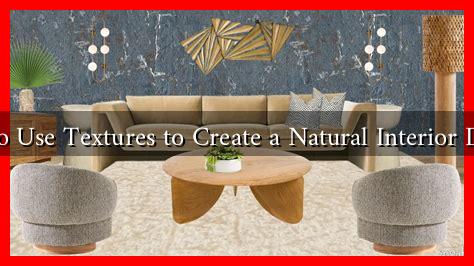-
Table of Contents
How to Use Textures to Create a Natural Interior Design
Interior design is an art that combines aesthetics with functionality, and one of the most effective ways to achieve a natural look is through the use of textures. Textures can evoke feelings of warmth, comfort, and connection to nature, making them essential in creating a serene living space. This article explores how to effectively use textures to create a natural interior design, providing insights, examples, and practical tips.
The Importance of Texture in Interior Design
Texture plays a crucial role in interior design for several reasons:
- Visual Interest: Different textures can add depth and dimension to a space, making it visually appealing.
- Emotional Connection: Natural textures can evoke feelings of calmness and relaxation, enhancing the overall ambiance.
- Contrast and Balance: Mixing textures can create a balanced look, preventing a space from feeling flat or monotonous.
According to a study by the American Society of Interior Designers, 70% of respondents believe that texture significantly impacts their emotional response to a space. This statistic underscores the importance of incorporating various textures into your design.
Choosing Natural Textures
When aiming for a natural interior design, it’s essential to select textures that reflect the beauty of the outdoors. Here are some popular natural textures to consider:
- Wood: Whether it’s reclaimed barn wood or sleek bamboo, wood adds warmth and a rustic charm.
- Stone: Natural stone surfaces, such as granite or slate, can bring an earthy feel to kitchens and bathrooms.
- Textiles: Fabrics like linen, cotton, and wool can soften a space and add comfort.
- Plants: Incorporating greenery not only adds texture but also improves air quality and enhances mood.
Layering Textures for Depth
Layering different textures is key to creating a rich and inviting space. Here are some tips on how to effectively layer textures:
- Mix Hard and Soft: Combine hard surfaces like wood or stone with soft textiles such as cushions and throws.
- Vary Finishes: Use a mix of matte and glossy finishes to create contrast. For example, pair a matte wooden table with glossy ceramic vases.
- Incorporate Natural Elements: Use natural materials like jute rugs or wicker baskets to add organic texture.
For instance, a living room designed with a plush wool rug, a leather sofa, and wooden coffee tables creates a harmonious blend of textures that feels both cozy and sophisticated.
Case Studies: Successful Natural Interior Designs
Several designers have successfully utilized textures to create stunning natural interiors. One notable example is the modern rustic home designed by Studio McGee. The use of reclaimed wood beams, stone fireplaces, and soft textiles creates a warm and inviting atmosphere that feels connected to nature.
Another example is the Wooden House by architect Kengo Kuma, which seamlessly integrates natural textures with its wooden facade and stone accents, creating a harmonious relationship with its surroundings.
Practical Tips for Incorporating Textures
To effectively incorporate textures into your interior design, consider the following practical tips:
- Start Small: If you’re new to using textures, begin with small decor items like cushions or throws.
- Use a Color Palette: Stick to a cohesive color palette to ensure that the different textures complement each other.
- Experiment: Don’t be afraid to mix and match different textures until you find a combination that feels right.
Conclusion
Incorporating textures into your interior design is a powerful way to create a natural and inviting space. By understanding the importance of texture, choosing natural materials, layering effectively, and learning from successful case studies, you can transform your home into a serene sanctuary. Remember to start small, use a cohesive color palette, and most importantly, have fun experimenting with different textures. With these strategies, you can achieve a beautiful and harmonious interior that reflects the beauty of nature.


